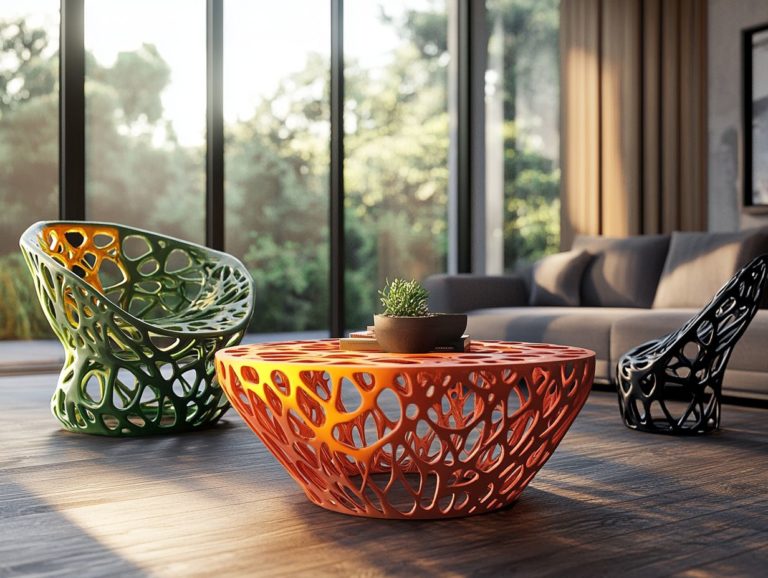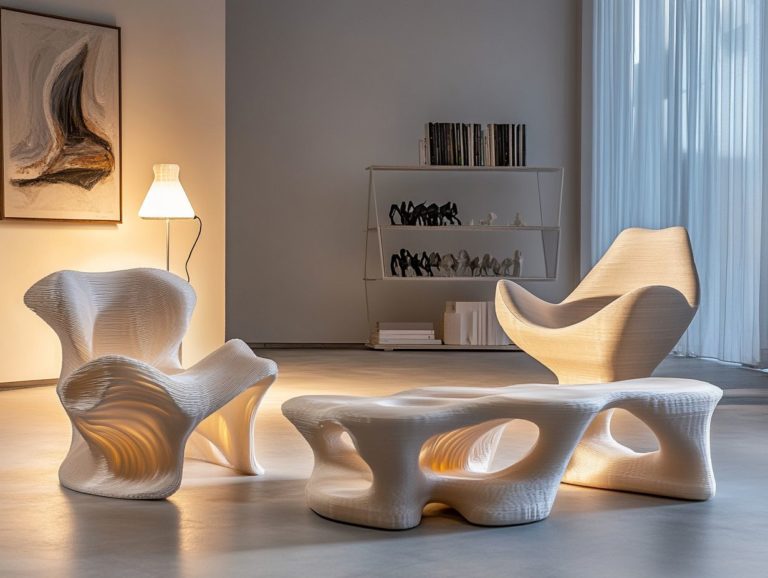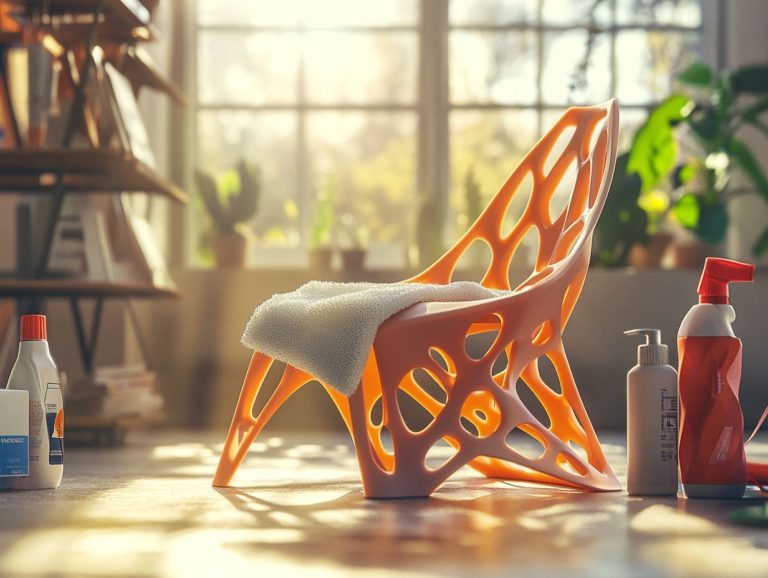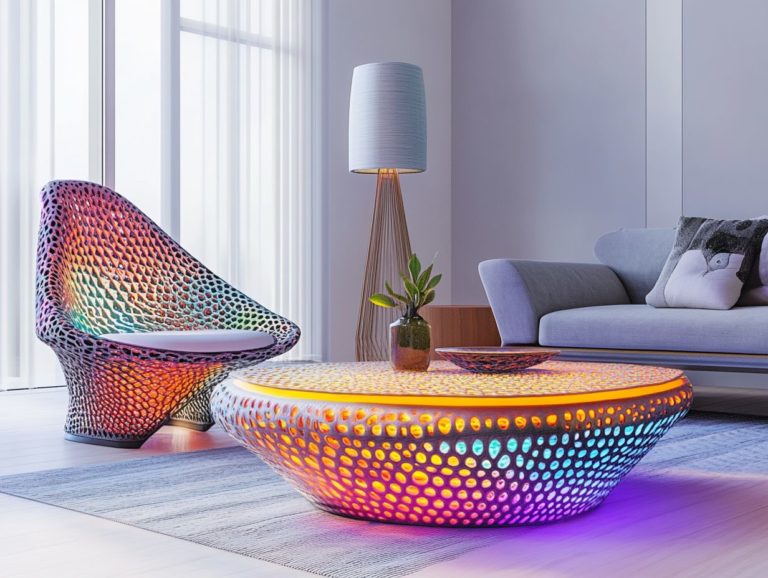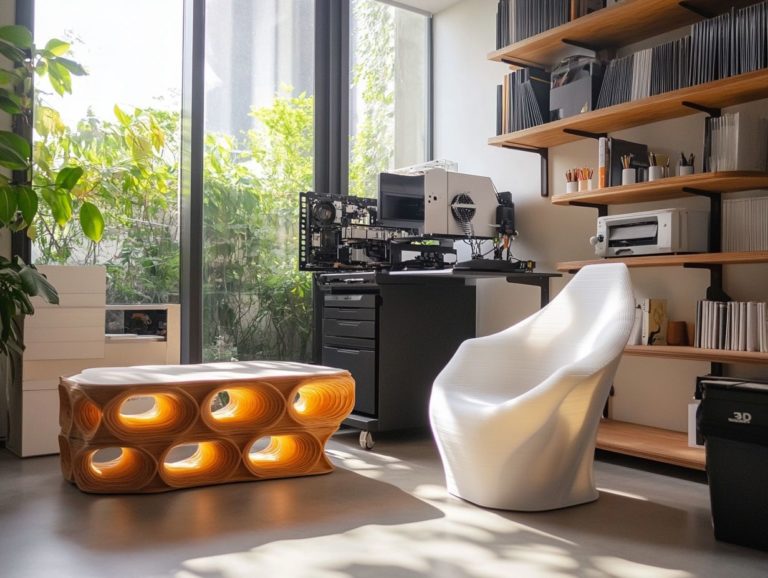Understanding the Technology Behind 3D-Printed Furniture
3D printing is revolutionizing your approach to furniture design and production. This cutting-edge technology presents great benefits, such as cost efficiency and limitless customization options, along with the ability to work with various materials, including plastics, metals, and composites.
In this article, you ll delve into the process of crafting 3D-printed furniture and explore its diverse applications across various industries. You’ll also consider its profound potential impact on the future of furniture design. Don t miss out on the future of furniture design!
Contents
Key Takeaways:

- 3D printing allows for cost-efficient and customizable furniture, making it a desirable option for consumers.
- A variety of materials, including plastics, metals, and composites, can be used in the 3D printing process for furniture.
- The use of 3D-printed furniture has the potential to greatly impact the furniture industry, bringing both challenges and opportunities for growth and innovation.
What is 3D Printing?
3D printing, or a way to build things layer by layer, represents a groundbreaking technology that allows you to create three-dimensional objects by layering materials according to digital designs. This innovative process has made waves across various industries, especially in domestic architecture and real estate. It enables rapid prototyping and customized designs that traditional manufacturing simply cannot achieve.
With the aid of computer-aided design (CAD) software, you can craft intricate shapes and structures that were once constrained by conventional construction techniques. The technology behind 3D printers often utilizes materials like plastic, metal, and even concrete. This allows you to produce durable and visually appealing objects. This evolution in manufacturing not only opens the door to bespoke furniture solutions but also reimagines how you can utilize space in your home.
As this additive manufacturing approach gains traction, it holds the promise of streamlining supply chains (the process of getting products from makers to buyers), reducing production costs, and fostering sustainable practices that significantly minimize waste in both furniture and architecture.
Advantages of 3D-Printed Furniture
3D-printed furniture presents a wealth of advantages that you simply can’t overlook. Imagine enjoying cost efficiency, unmatched customization, and innovative designs that prioritize lightweight prototypes all tailored just for you. As 3D printing technology continues to evolve, manufacturers can craft custom-designed furniture that aligns perfectly with your unique preferences and needs.
This not only elevates your overall experience but also optimizes production costs, making it a win-win situation for everyone involved.
Cost-Efficiency and Customization
Cost-efficiency and customization stand out as two of the most significant advantages of 3D-printed furniture. They allow you to create unique pieces without the high costs typically tied to bespoke furniture manufacturing.
This transformative technology minimizes material waste and drastically cuts down production time. This makes it an enticing option for both small-scale artisans and large manufacturers alike. Take, for instance, the One Shot Stool by Patrick Jouin; it perfectly illustrates how 3D printing can streamline the design process while providing you with a distinctive, personalized element for your space.
With the ability to choose colors, patterns, and even sizes, 3D printing fosters a meaningful connection between you and the product. This results in furniture that aligns seamlessly with your individual tastes and functional needs. These innovations showcase the potential for cost savings while enriching your experience, proving that personalization and affordability can indeed go hand in hand.
Types of Materials Used in 3D Printing

The range of materials available for 3D printing has broadened impressively. It encompasses everything from classic plastics and metals to cutting-edge composites and biodegradable options.
Among these exciting developments are mycelium biomaterials, which present a sustainable solution for furniture design. What would you create with 3D printing?
Plastics, Metals, and Composites
Plastics, metals, and composites emerge as the cornerstone materials in 3D printing. Each delivers distinct advantages that enhance various facets of furniture manufacturing.
Plastics are your go-to option lightweight and versatile. They can be effortlessly molded into intricate shapes, making them perfect for crafting ergonomic furniture solutions. Meanwhile, metals stand out with their exceptional strength and durability, ideal for creating robust items that can handle substantial loads. Composites present a harmonious blend of both worlds, enabling innovative designs that are not only lightweight but also remarkably strong.
By harnessing the precision offered by these materials, you can delve into complex geometries and tailored functionalities. This significantly elevates manufacturing efficiency. This focus on material specificity speeds up prototyping and reduces waste, paving the way for a more sustainable approach to furniture design.
How 3D-Printed Furniture is Made
The creation of 3D-printed furniture immerses you in a complex and captivating printing process. It all begins with the design phase, where prototypes and models are meticulously crafted, transforming inventive ideas into tangible reality.
The Printing Process and Design Considerations
The process of creating 3D-printed furniture involves many design factors that significantly affect both aesthetics and functionality. This requires you to possess a profound understanding of furniture design principles and the underlying technology.
One of the key aspects you must consider is the delicate balance between form and function. Each piece should captivate the eye. It must also effectively serve its intended purpose. Your choice of materials plays a pivotal role, influencing both the visual texture and the durability of the final product. This leads to innovative solutions that traditional methods may simply not allow.
With advancements in printing technology, such as multi-material printing, you have the opportunity to explore unique combinations that enhance ergonomics while preserving artistic integrity. By harnessing these technologies with intention, you can create pieces that not only stand out visually but also provide an exceptional user experience.
Applications of 3D-Printed Furniture
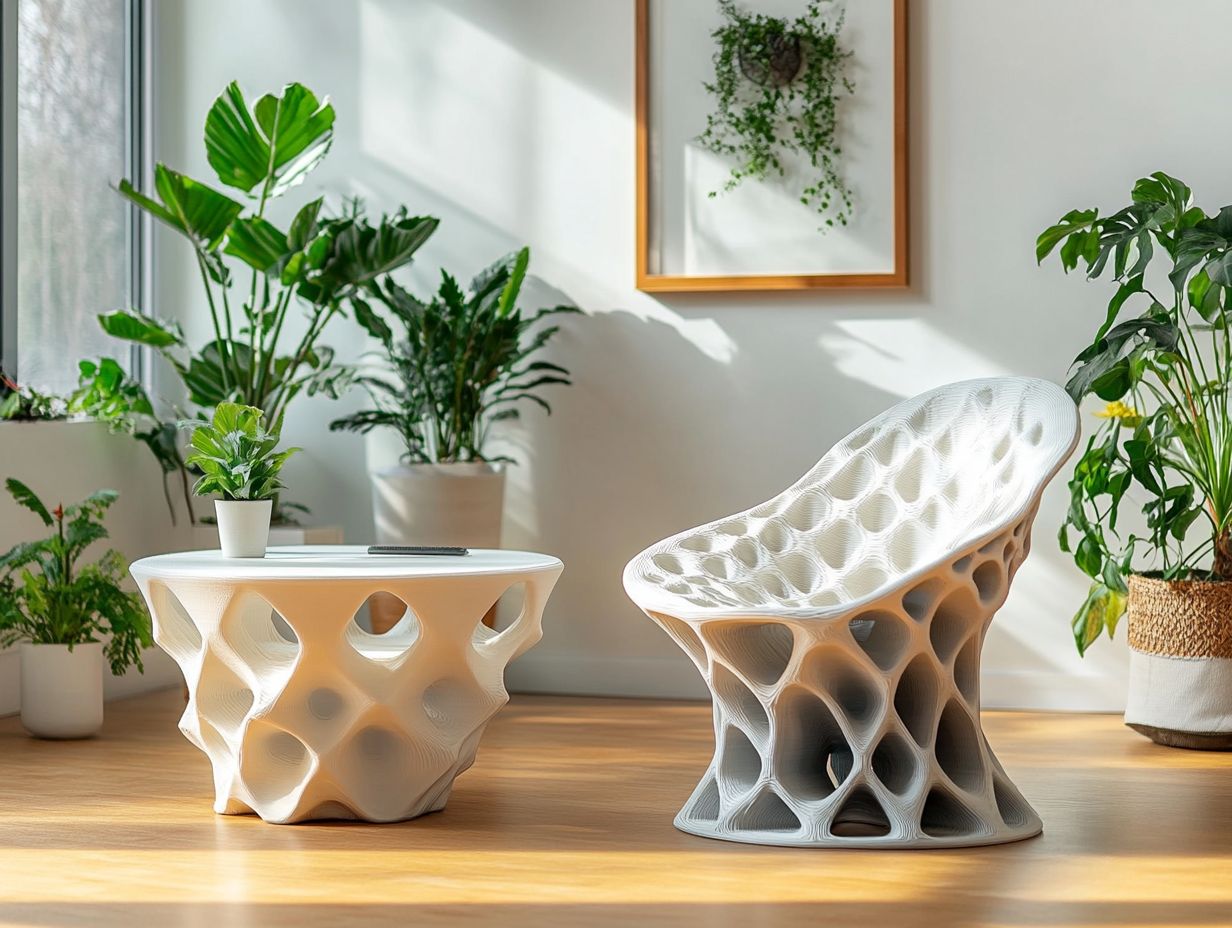
Explore the exciting ways 3D-printed furniture is transforming countless industries. Its applications extend across a multitude of industries, highlighting its remarkable versatility and adaptability in today s furniture market. Whether for residential homes or commercial spaces, this innovative approach to furniture design reshapes how you think about style and functionality.
Industries and Uses
Discover how various industries are eagerly adopting 3D-printed furniture, from interior design to product development. Think about how decorative hardware and custom pieces are crafted specifically for individual clients.
In the realm of interior design, imagine having bespoke elements like intricately designed light fixtures and tailored shelving units produced swiftly to cater to your unique aesthetic and functional needs. The architectural sector isn t left behind either; it utilizes 3D printing to create prototypes of furniture. This allows you to visualize how pieces will look in place before committing to actual production.
The hospitality industry is also getting in on the action, customizing furniture for hotels and restaurants to reflect their brand identity and elevate the customer experience. Meanwhile, the educational sector is exploring how 3D printing can transform learning environments, crafting innovative furniture solutions that foster interactivity and functionality.
Potential Impact on the Furniture Industry
The potential impact of 3D printing on the furniture industry is nothing short of transformative. It offers a range of challenges and opportunities that could redefine sustainable business models and manufacturing practices. Embracing this technology may not only enhance creativity and customization but also pave the way for more eco-friendly production methods that resonate with conscious consumers.
Imagine the future of furniture design and consider how you can leverage 3D printing in your own projects!
Challenges and Opportunities
The challenges and opportunities in the 3D-printed furniture business are intricately linked. Obstacles in the design process often spark innovative breakthroughs.
As you navigate the rising costs of materials and the pressing demand for quicker production, these hurdles can actually fuel your creative thinking. This exploration may lead you to alternative materials.
For instance, you might experiment with sustainable materials that help cut costs and resonate with environmentally conscious consumers. The drive for faster production inspires advancements in technology, such as enhanced printing techniques and automation.
These innovations don t just tackle current challenges; they also open the door to distinctive, customizable furniture options that cater to individual tastes. Ultimately, this positions your business for impressive growth.
Frequently Asked Questions
What is 3D printing technology?
3D printing technology is a process of creating three-dimensional objects from a digital model. A digital model is a virtual representation that guides the printer in laying down successive layers of material.
How does 3D printing work for furniture?
3D printing for furniture starts with a digital design of the furniture piece, which is sliced into multiple layers. The 3D printer then prints these layers one by one using various materials such as plastic, metal, or wood to create the final product.
What are the benefits of 3D-printed furniture?
There are several benefits of 3D-printed furniture, including faster production times and customization options. 3D printing also enables the creation of complex and intricate designs that may not be possible with traditional manufacturing methods.
What materials are used for 3D-printed furniture?
Common materials used for 3D-printed furniture include plastic, metal, and wood-based filaments. Each material offers unique properties and can be customized to achieve the desired strength, texture, and color.
Is 3D-printed furniture durable?
Yes, 3D-printed furniture can be very durable depending on the material used and the design of the piece. With advances in technology, 3D-printed furniture can be just as strong and long-lasting as traditionally manufactured furniture.
How does 3D printing impact the furniture industry?
Imagine how 3D printing could transform the furniture industry! It s changing how furniture is designed and produced, allowing for more efficient and sustainable manufacturing processes.
Ready to dive into the world of 3D-printed furniture? Start your journey today!


